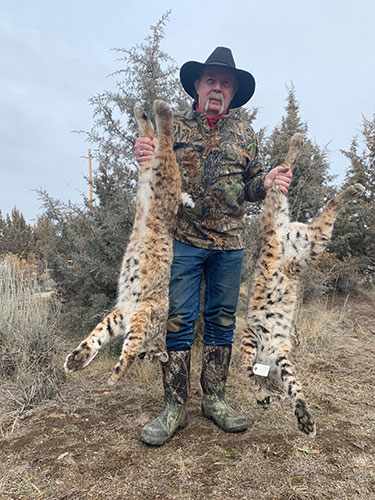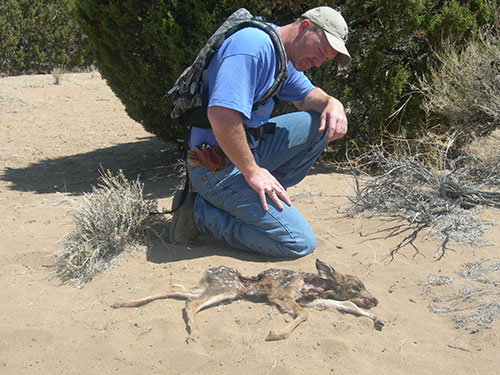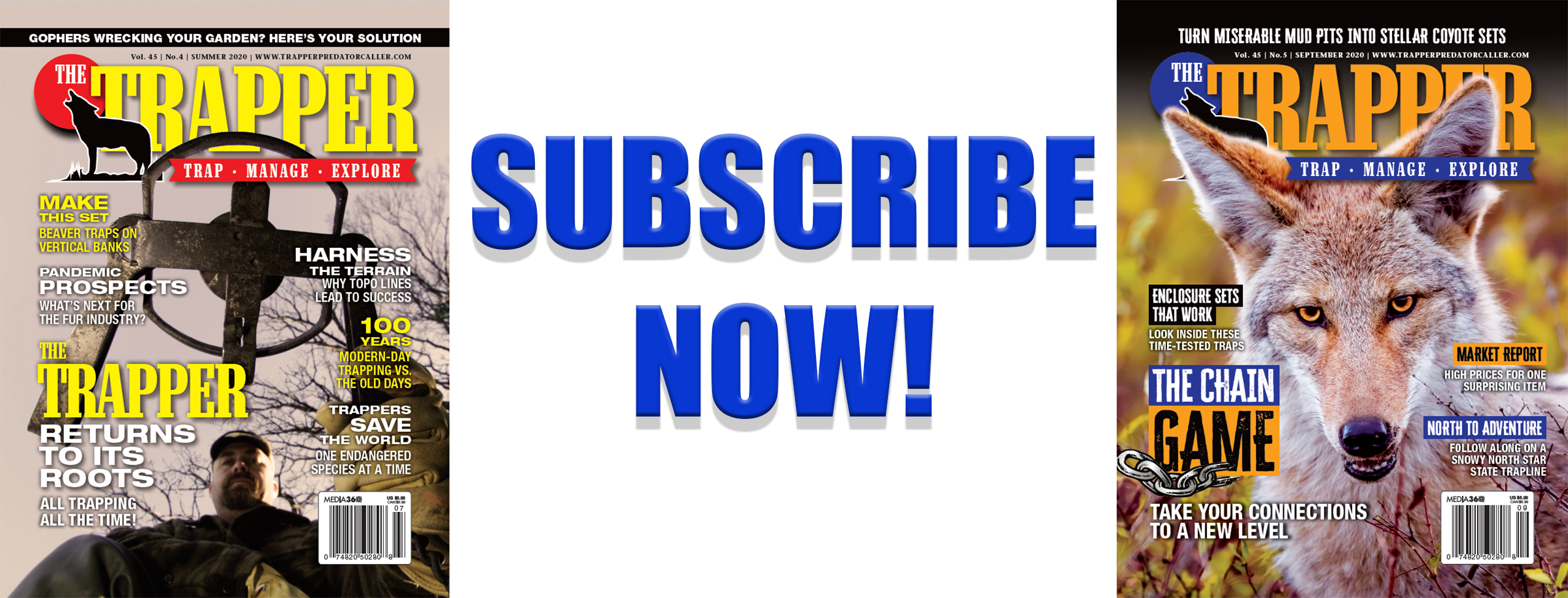Fence snares have saved many a calf, lamb and fawn from toothy predators.
By Jack Spencer Jr.
Long ago homo sapiens being the ingenious species they are, invented some pretty amazing, life-changing contraptions. The wheel, the nail, gunpowder, bubbles in beer, trapping magazines and in 1867 barb wire, the ultimate cow stopper. Having personally lived a life filled with a few mean cows, I feel the creation of barbwire is one of my favorites.
I have built miles of five-strand barbwire T-post fencing, taught to me by an old Nevada fence master himself. I tip my hat to Lucien Smith, the first person to patent barbed wire, or basically the man who harnessed cows. Barbed wire single-handedly ended most long-range cattle drives, yet opened the door for a wide variety of other types of woven wire fencing.

The author has snared a truckload of coyotes in a day a few times during his career. Photo credit Jack Spencer Jr.
Then about the time the cowboys had the whole barbwire and cow thing figured out, along came domestic sheep. The smaller domesticated sheep required a more specialized fencing, capable enough to withstand ewes and lambs from ranging free. Woven fence usually with open areas no bigger than a human hand seemed the perfect fit. This new “sheep fence” appeared to be the perfect marriage for keeping sheep contained. Fencing also proved somewhat effective at keeping coyotes and sheep separated, until the novelty wore off and coyotes being the masterful predators they are, simply learned to crawl under, over and sometimes through fencing.
Every halfway sane sheep producer I know only wishes they could effectively keep coyotes fenced out away from their vulnerable livestock, however, that’s not likely to happen anytime soon. A secure predator-proof fence is doable, but bring your checkbook and the end result is going to look like fence capable of holding back an elephant. Damn coyotes, anyway.
Protecting livestock is one thing, but there are a host of other valuable high-fenced, high-dollar, grass-munching animals. A domestic sheep or goat on average can fetch roughly $150 to $350 each, with cattle calves going for $400 to $600 each. In some states, exotic species such as Indian black bucks, axis deer, African aoudad and mouflon sheep commonly sell for more than traditional livestock — a lot more. Also, high-fenced white-tailed deer can sell for several thousand to more than $10,000-plus dollars for an end result high-scoring trophy buck. Understandably, it pays to protect resources that create a monetary livelihood for the domestic, exotic and wildlife rancher.

The author’s father, Jack Sr., is an Oregon trapper who has snared more than 8,000 animals in fence snares, including high-dollar cats. Photo credit Jack Spencer Jr.
I have a Basque sheepherding friend who runs domestic sheep south of my place, who always reminds me that every animal counts, and the Basque are well known for the care of their livestock.
With high dollars spent enclosing animals from roaming the countryside, those same dollars can afford an easy meal for predators, once they make the journey across the wire. We don’t know the first person who developed the snare in this country, but I’m sure it was long before non-native settlers arrived and the poor soul probably wasn’t afforded with high-tensile-strength aircraft cable like we can readily order from the Snare Shop (www.snareshop.com) today.
The first snare was probably woven from sinew or rawhide, and likely used to snare prey items from the tiniest pygmy rabbits up to large deer and moose species. I theorize the person was a Native American and probably wasn’t worried much about the ever-changing fur market, only securing food for the family.
Snares that protect grass-munching ungulates are what I call “snares that care.” Construction of such snares is actually pretty easy and after building thousands, one can build them without thought.
I recommend wearing safety equipment even though the threat of injury while building snares is low, sometimes things can happen. I don’t swag stops on snares because it’s too damn time consuming for my snare-building operation. When I’m building snares by the hundreds, I place the stops where needed next to the cam lock and one in back of the snare, near the end of the attachment anchor. I simply slide on a stop, apply a couple of whacks with the hammer to smash the stop down, and on to the next stop. I try not to hit the stops more than a few times or two things can happen. First, if you smash the stops too flat, they can split. And second, if the stops are too compressed around the cable, they can actually cut the cable, and can weaken a snare’s holding capability.
Sometimes trimming cable, especially when trimming ends behind the stops, can send small cable strands flying, and you don’t want to know what a little strand of cable feels like in your eye, a painful mistake I wish I didn’t make. So, I wear safety glasses and employ the use of black electrical tape for certain spots on the fingers that become worn or subject to blisters. Regular work gloves just don’t afford me the sensitivity that I require when building snares, however, I have discovered that thin latex rubber gloves work for a while before ripping, and can keep the snare cable grease from imbedding into your hands. Everyone has their own way of doing things, but when making snares by the bucket load each year, efficiency and comfort with safety in mind are very important.

Snare-making duty can be tedious, but once you get in a rhythm with some experience, you can make them pretty quickly. Photo credit Jack Spencer Jr.
When building fence snares, I prefer 4-foot-long snares, allowing for a little more length in case I need it, a 3/32-diameter cable, an aggressive and reusable nonrelaxing cam lock, and a swivel at the end. This setup works well for coyotes, raccoons, cougars and the occasional small pig that utilizes coyote crawl holes.
There are many different fence snare options and basically everything works, just some contraptions work better than others. If I find oversized holes where large, feral pigs are going under, I never tie the snare to the fence, but rather use a drag, so that the oversized beasts can drag away from the fencing. I have had pigs, on occasion, get tangled in fencing — talk about a mess and angry frowns from cowboy fence riders. The 3/32 cable can be a little slower when cinching loops, however, it’s much more durable for longer soaking times between trap checks. Sometimes, to increase snare speed, I move up to the heavier 1/8 cam lock, but still stay with the 3/32 cable.
If I need to worry less about the occasional pig and more about coyotes, bobcats and gray foxes, I simply reduce fence snare length to 3 feet or shorter, 1/16 cable, swiveled and armed with the little gritty 1/16 cam lock. Usually where I hang fence snares is somewhere along the Mexican border, and ranch hands drive the perimeter fence daily, so captured animals don’t stay in snares all that long, thus helping to reduce the possibility of chew-outs. The smaller diameter cable also affords me more neck catches, which means less digging and fence damage around the crawl holes. The swiveled 1/16 snares slide much faster and cinch tight, however, they should be checked daily or there can be a strong likelihood of chew-outs or twist-outs, even with a swivel. With that being said, the 3/32 snare setup is my go-to fence snare.
So how long does it take to construct a simple fence snare? Ironically, I can make a fence snare and set a fence snare in about the same amount of time, one minute when things are clicking. Of course, setting fence snares may take longer because of varying conditions and locations, but when it all comes together it can go fast. Making snares is a ho-hum experience with little time variation. I can build a fence snare in about 45 seconds when the precut cable and parts lay before me, and 90 seconds as time goes by, especially as my fingers start to wear out or if I have re-tape my fingers to prevent blisters.

Pre-made snares of different sizes and lengths come in handy for many different situations. Photo credit Jack Spencer Jr.
After building my snares I carefully wrap them in small circles, paint them with flat gray paint, let them air dry for a few weeks, then place them in ziplock storage bags. Some may cringe at painting fence snares, but there’s not much surface on a snare to hold a great deal of scent. I have had the same fence snare set for nearly two years before a coyote used a particular crawl hole. I have other fence snare locations that catch a coyote every month. While it may take a little training to teach someone how to trap a coyote, I have watched people who have never trapped before set fence snares and catch multiple coyotes in a week’s time.
Just prior to the deer fawning season, my presence was requested in no-man’s land along the Mexico-U.S. border, toting hundreds of fence snares. I had an old ranch hand driver assigned to me as I sat in a seat affixed to the front bumper of the truck. We hastily drove along an 8-foot-high wire woven fence and when I found a hole that needed a snare, I hollered “alto.” The truck stayed running, I made a loop, one wire to hold the snare in the crawl hole, and a double wire to secure the snare, and off we went.
Crawl holes were numerous and by the end of several day’s work from dark to dark I had placed 423 fence snares. I could have set even more snares out. Some of the holes I just blocked with debris to force predators to simply walk to the next snare-laced hole. In that part of the country, almost anything with a pointed tooth is afforded with almost no heavy-handed trapping regulations, and all predators are fair game except black bears and jaguars.

The author discovered this coyote-killed fawn on a ranch as he scouted for the best snare locations. Photo credit Jack Spencer Jr.
After the last fence snare was set I figured it was safe to say that I was an official longliner and it was the most equipment I ever had out at one time, but really what is considered a long line anyway? I have had a 100-mile bobcat line and only two dozen traps placed in honey holes far off the road. It took me all day to check the cat traps and my tired legs thought it was long. In a thick, infested beaver river trapline, 50 conibear sets over many river miles can be a lot of work, whereas 100 fence snares in the same distance might be a much easier long line to handle. There are a lot of variables to what constitutes a long line for the many trapping scenarios.
Checking all of those snares was exciting and after the first day checking them, I had to shake loose eight coyotes, two bobcats and was a little surprised at how many gray foxes and armadillos were in the unfamiliar country. I was expecting many more coyotes, but in that particular area there were not that many coyotes. I was, however, a little taken aback by how big the coyotes were. My ranching friend was ecstatic, and in the next two weeks I caught all kinds of toothy predators. The end results equated to exceptional deer fawn counts by late fall, something that hadn’t happened on that particular ranch in years.
Autumn found me placing fence snares here in my home state of Nevada, for my ranching neighbors and my personal calving area. The lure of fresh afterbirth and excreted bloody calf crap can bring in every coyote from far and wide.
The presence of a dead cow on the landscape is tough on the pocketbook, but if it’s cold, the carcass lasts much longer and coyotes by the dozens take advantage of the free protein. There is a nearby feedlot and when they have a dead cow, the cowboys call and I come running. The cowboys happily load it in my old one-ton Dodge pickup and I usually haul it to a corner of the property along the fence.
Within hours the clever ravens have located the dead cow and all of the cawing and visual aerobatic flights can be heard and seen by every coyote within five miles or more. I usually place fence snares out the same day that I place the carcass out, but I choose to close the snare loops and let the coyotes feast for a few days. The “last supper” scene secures the deal.
When I feel I have all of the coyotes in the area trained on the bait, I simply open the fence snares and start checking them daily. I’ve had some pretty big trap days over the years, but in the fall months, I have actually caught a truckload of coyotes of more than 20, a time or two. Good fencing, high coyote densities, a ton of bait, cold temperatures and well-placed snares can be scary effective.
Fence snares placed in crawl holes are truly locations where many predators can be constricted to one specific site without a great deal of coercing. My father is a retired trapper and the man has probably fence-snared more than 8,000 predators, and he likes to find locations where they’re restricted to a single crawl hole. He avoids the larger crawl holes since deer, lions and even bears can simply slide through them. He has also found crawl holes to be a highly effective means of securing high-dollar bobcats.
No matter where I travel across North America, every time I see tight-woven fencing I look for crawl holes. Snaring predators in fences is what I would consider the most basic method of trapping and one of the easiest methods to place a lot of equipment out, and it’s very economically efficient.
Over the years I have learned that not all coyotes are bad and not all coyotes are good, but all coyotes seem to kill prey that’s desired by humans. The coyotes that feast on the crazy cat lady’s cats down the road from me are well, in my opinion, a godsend. But, the coyotes that eat more than their share of mule deer fawns in my favorite deer unit quickly get placed on my hit list. Those coyotes have their days numbered and any and all legal methods are fair game in my book.
Fence snares placed in the right locations are undoubtedly one of the most effective means of protecting valuable protein that needs protecting — domestic or wild.


